Technical Documentation in Y-Axes Solutions
Technical documentation in software engineering is the umbrella term that encompasses all written documents and materials dealing with software product development. All software development products, whether created by a small team or a large corporation, require some related documentation. And different types of documents are created through the whole software development lifecycle (SDLC). Documentation exists to explain product functionality, unify project-related information, and allow for discussing all significant questions arising between stakeholders and developers.
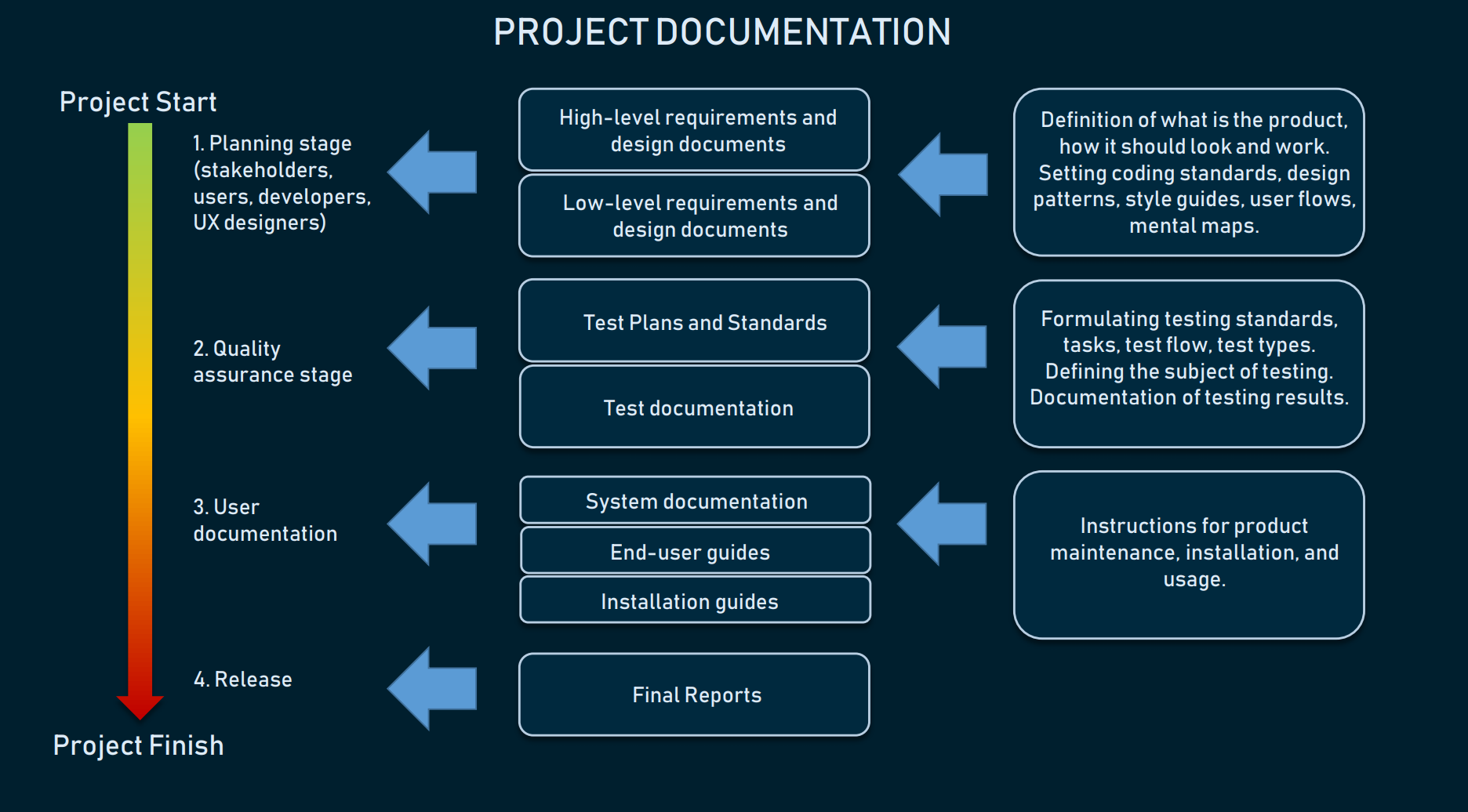
On top of that, documentation errors can set gaps between the visions of stakeholders and engineers and, as a result, a proposed solution won’t meet stakeholders expectations. Consequently, managers should pay a lot of attention to documentation quality.
The documentation types that the team produces and its scope depending on the software development approach that was chosen. There are two main ones: agile and waterfall. Each is unique in terms of accompanying documentation.
The Waterfall approach is a linear method with distinct goals for each development phase. Teams that use waterfall spend a reasonable amount of time on product planning in the early stages of the project. They create an extensive overview of the main goals and objectives and plan what the working process will look like. Waterfall teams strive to create detailed documentation before any of the engineering stages begin. Careful planning works well for projects with little to no changes in progress as it allows for precise budgeting and time estimates. However, waterfall planning has proven to be ineffective for long-term development as it doesn’t account for possible changes and contingencies on the go. According to PMI’s 9th Global Project Management Survey, the Agile approach is used by 71 percent of organizations for their projects.
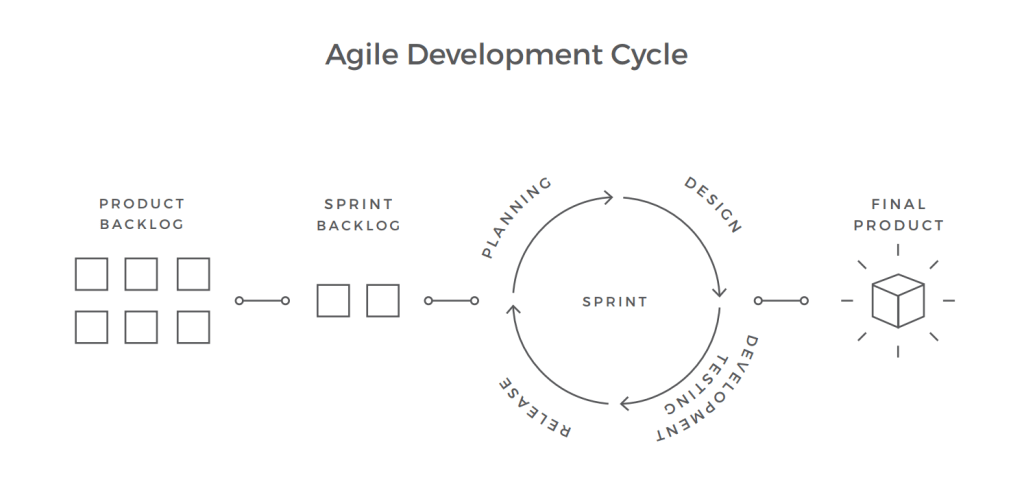
The agile approach is based on teamwork, close collaboration with customers and stakeholders, flexibility, and ability to quickly respond to changes. The basic building blocks of agile development are iterations; each one of them includes planning, analysis, design, development, and testing. The agile method doesn’t require comprehensive documentation at the beginning. Managers don’t need to plan much in advance because things can change as the project evolves. This allows for just-in-time planning. As one of the Agile Manifesto values suggests, putting – “working software over comprehensive documentation -“, the idea is to produce documentation with information that is essential to move forward, when it makes the most sense.
Today, agile is the most common practice in software development, so we’ll focus on documentation practices related to this method.
Types of documentation
The main goal of effective documentation is to ensure that developers and stakeholders are headed in the same direction to accomplish the objectives of the project. To achieve them, plenty of documentation types exist.
Adhering to the following classifications.
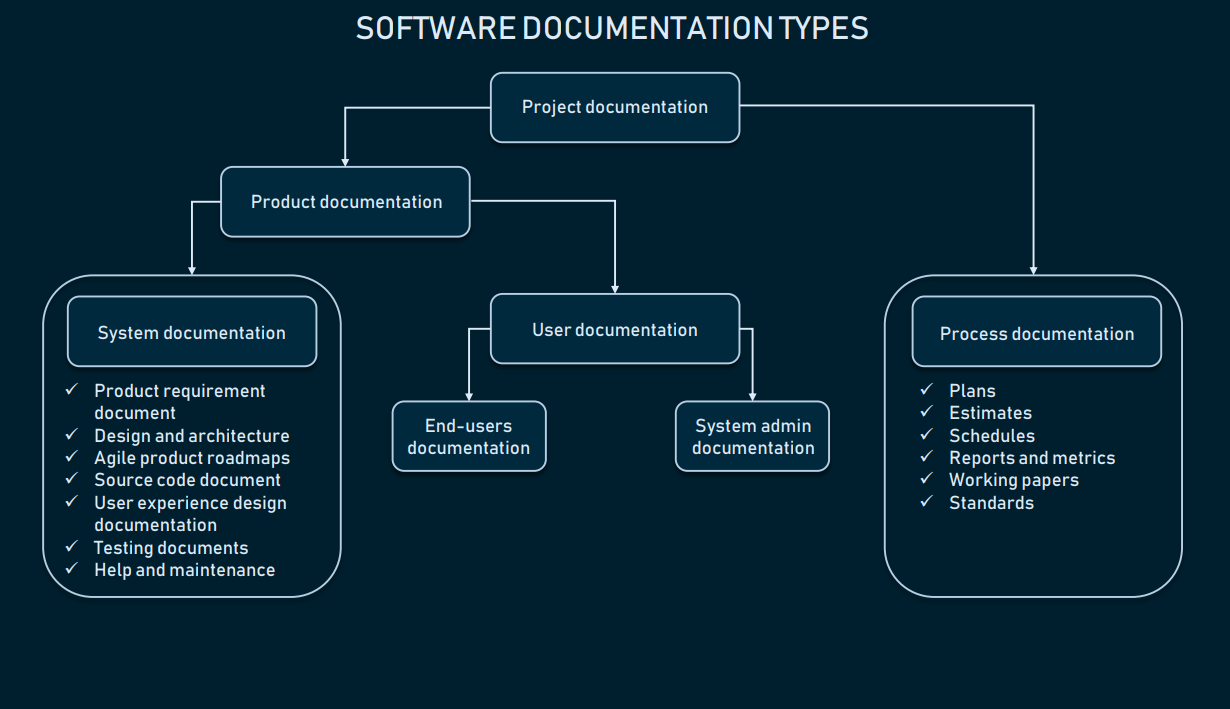
All software documentation can be divided into two main categories:
Product documentation describes the product that is being developed and provides instructions on how to perform various tasks with it. In general, product documentation includes requirements, tech specifications, business logic, and manuals. There are two main types of product documentation:
Process documentation represents all documents produced during development and maintenance that describe… well, the process. The common examples of process-related documents are standards, project documentation, such as project plans, test schedules, reports, meeting notes, or even business correspondence.
The main difference between process and product documentation is that the first one record the process of development and the second one describes the product that is being developed.
Product: System documentation
System documentation provides an overview of the system and helps engineers and stakeholders understand the underlying technology. It usually consists of the requirements document, architecture design, source code, validation docs, verification and testing info, and a maintenance or help guide. It’s worth emphasizing that this list isn’t exhaustive. So, let’s have a look at the details of the main types.
Product requirement document
A product requirement document or PRD provides information about system functionality. Generally, requirements are the statements of what a system should do. It contains business rules, user stories, use cases, etc. This document should be clear and shouldn’t be an extensive and solid wall of text. It should contain enough to outline the product’s purpose, its features, functionalities, maintenance, and behavior.
The best practice is to write a requirement document using a single, consistent template that all team members adhere to. The one web-page form will help you keep the document concise and save the time spent on accessing the information. Here’s a look at an example of a one-web-page product-requirements document to understand various elements that should be included in your PRD. Nevertheless, you should remember that this isn’t the one and only way to compile this document.
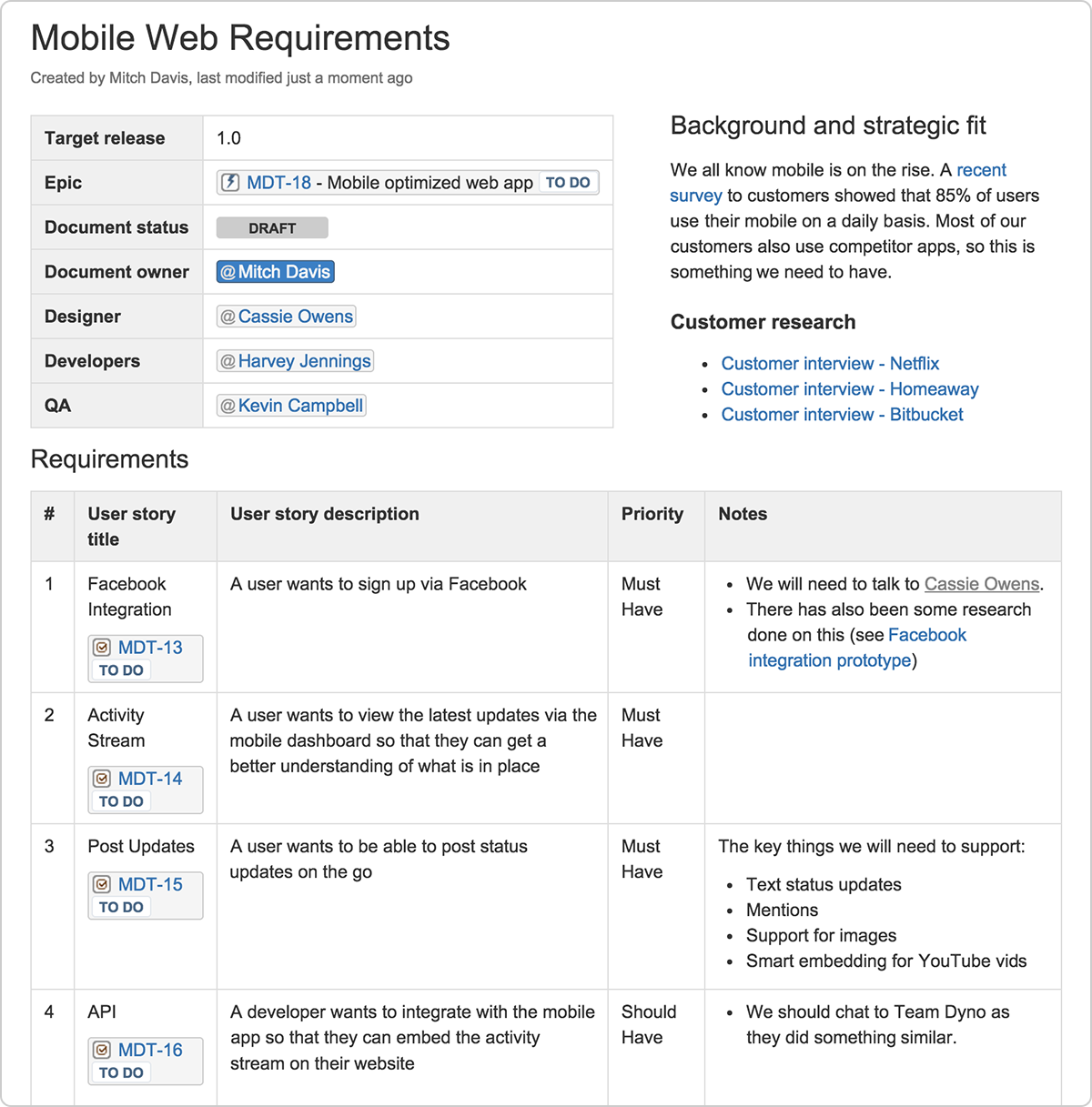
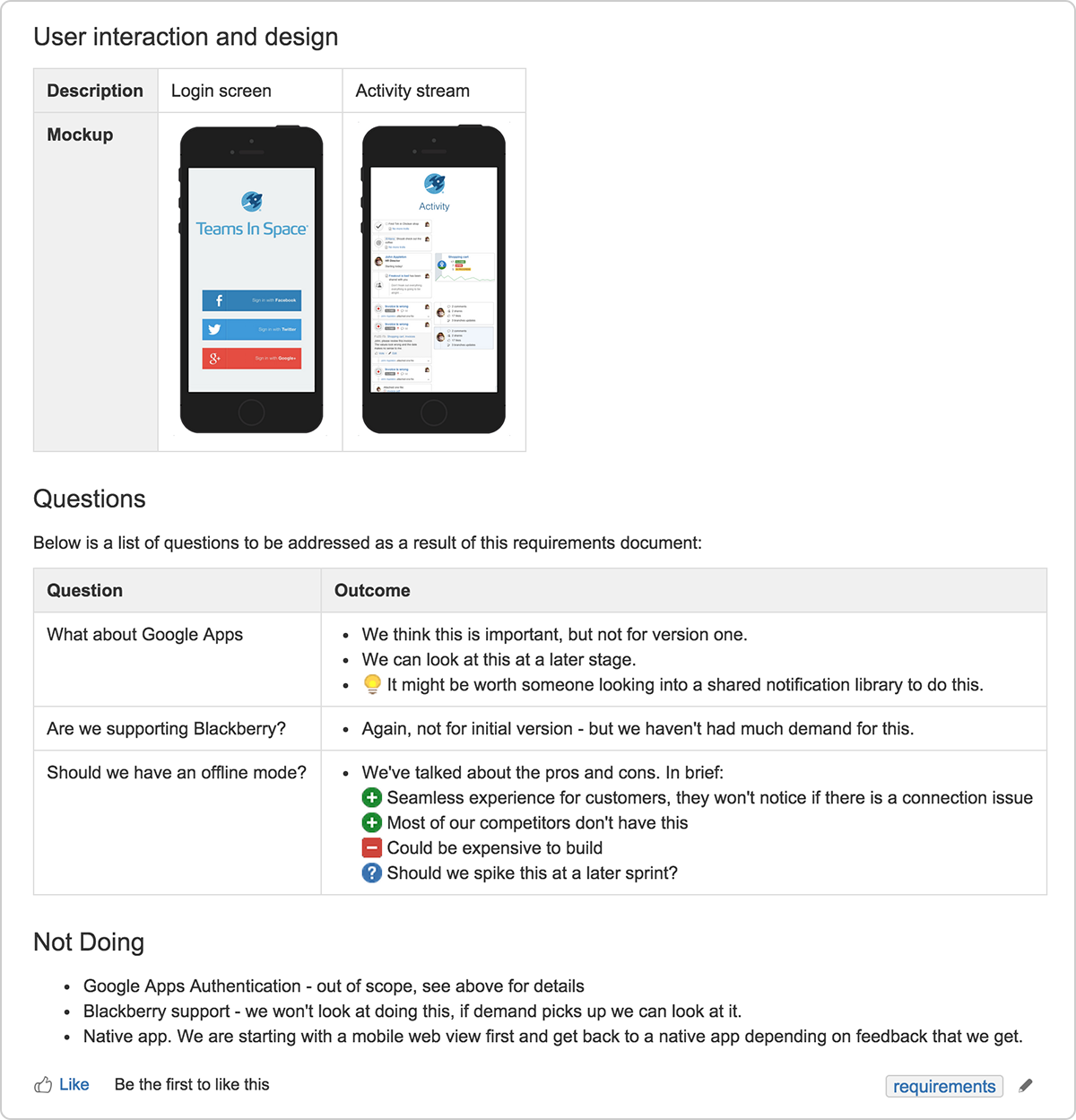
Here are the main recommendations points to include in your product requirement document:
Make all this information more comprehensive by using the following practices:
User experience design begins at the requirements stage and proceeds through all the stages of development, including the testing and post-release stages. The process of UX design includes research, prototyping, usability testing, and the actual designing part, during which lots of documentation and deliverables are produced.
The UX documentation can be divided into stages. The research stage includes:
User Personas are created and documented during the research stage. The information gathered during user interviews and surveys is compiled into functional user persona documents. User personas represent the key characteristics of real users, focusing on behavior, thought patterns, and motivation.
A user scenario is a document that describes the steps a user persona will take to accomplish a specific task. User scenarios focus on what a user will do, rather than outlining the thought process. The set of scenarios can be either visual or narrative, and describe the existing scenarios or future functionality.
Scenario maps are used to compile the existing user scenarios into a single document. Scenario maps show all possible scenarios available at a given moment. The main purpose of a scenario map is to depict all the possible scenarios for every single function, as well as intersecting scenario steps.
A user story map is formed from the backlog of the product. This type of document helps to arrange the user stories into future functions or parts of the application. A user story map can be a scheme, or a table of user stories grouped in a particular order to denote the required functions for a certain sprint.
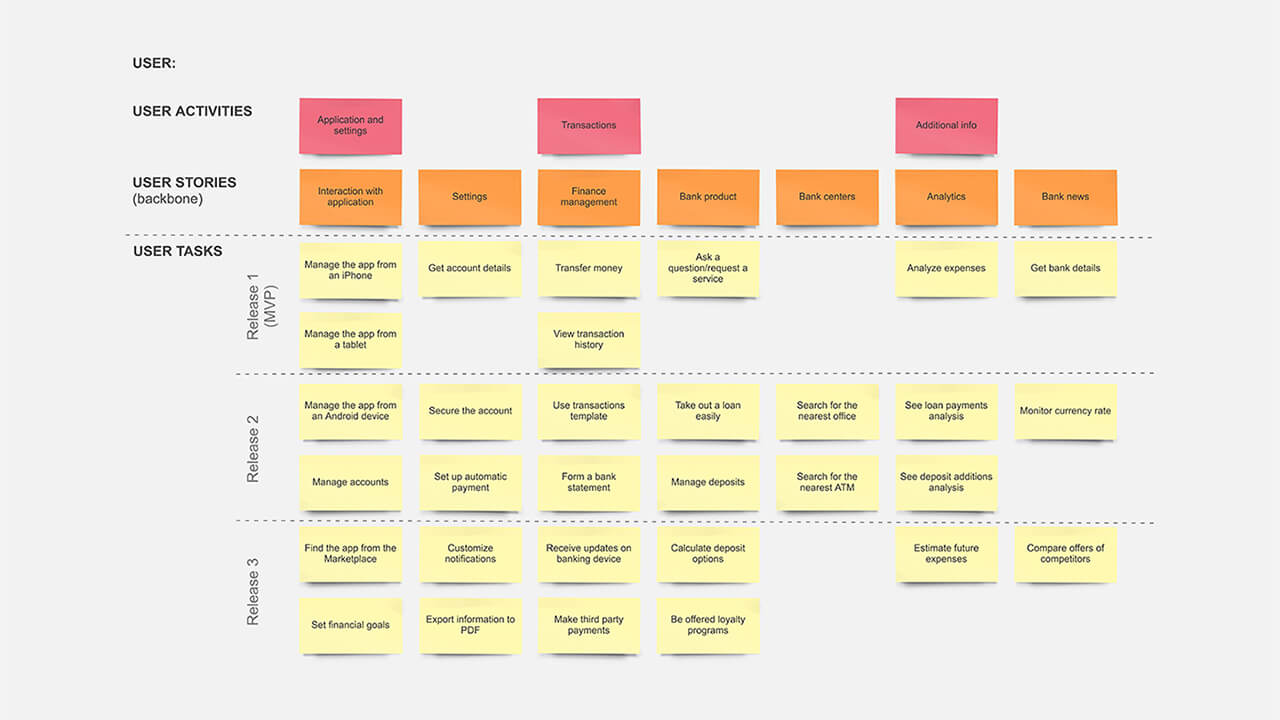
The UX style guide is a document that includes the design patterns for the future product. It also describes all possible UI elements and content types used, defining the rules of how they should be arranged and work with each other. But, unlike a UI style guide, UX designers don’t describe the actual look of the interface.
On the stage of prototyping and designing, a UX designer often works with the deliverables and updates documentation on par with other team members, including product owner, UI designers, and development team. The most common documents produced at these stages are:
A site/product map is a visual scheme that represents the connection between all pages of a product. The map helps the whole team visualize the structure of a website or app and the connections between the pages/functions. Creating a site map is a part of arranging the information architecture.
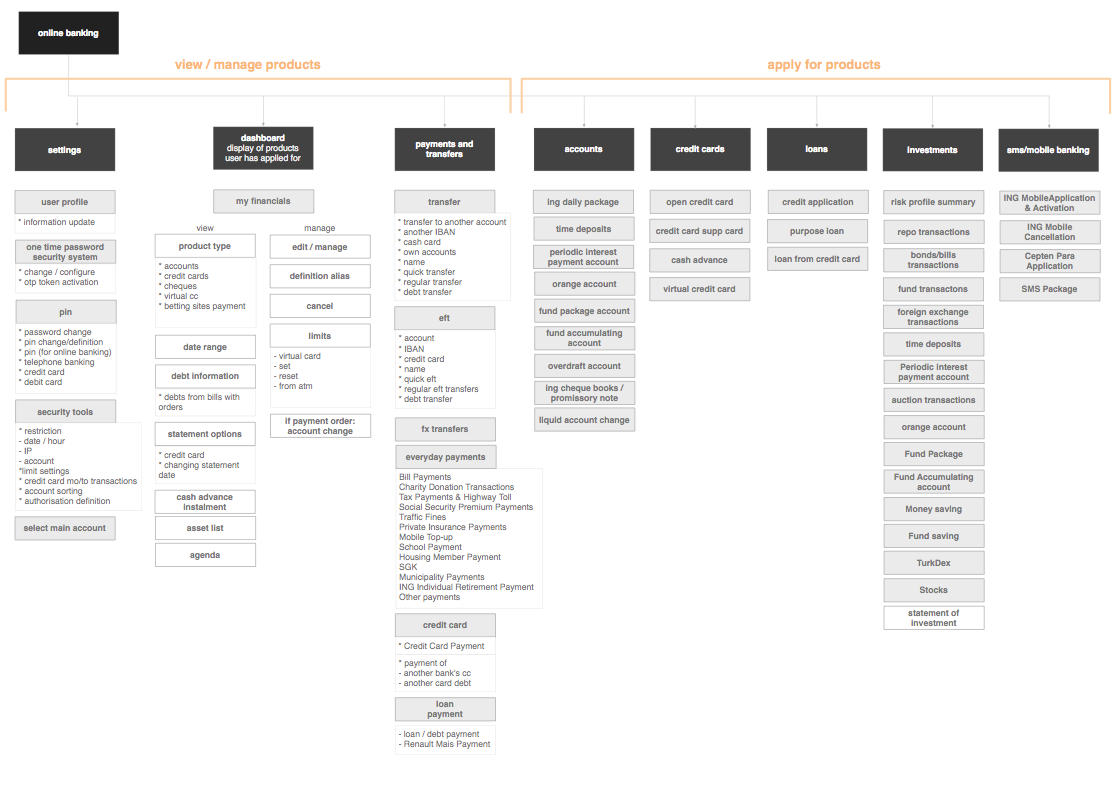
User flow or user journey schemes help the team to map the steps a user should take through the whole product. The main task of a user flow scheme is to depict the possible steps a user may take, going from page to page. Usually, the scheme includes all the pages, sections, buttons, and functions they provide to show the logic of user movement.
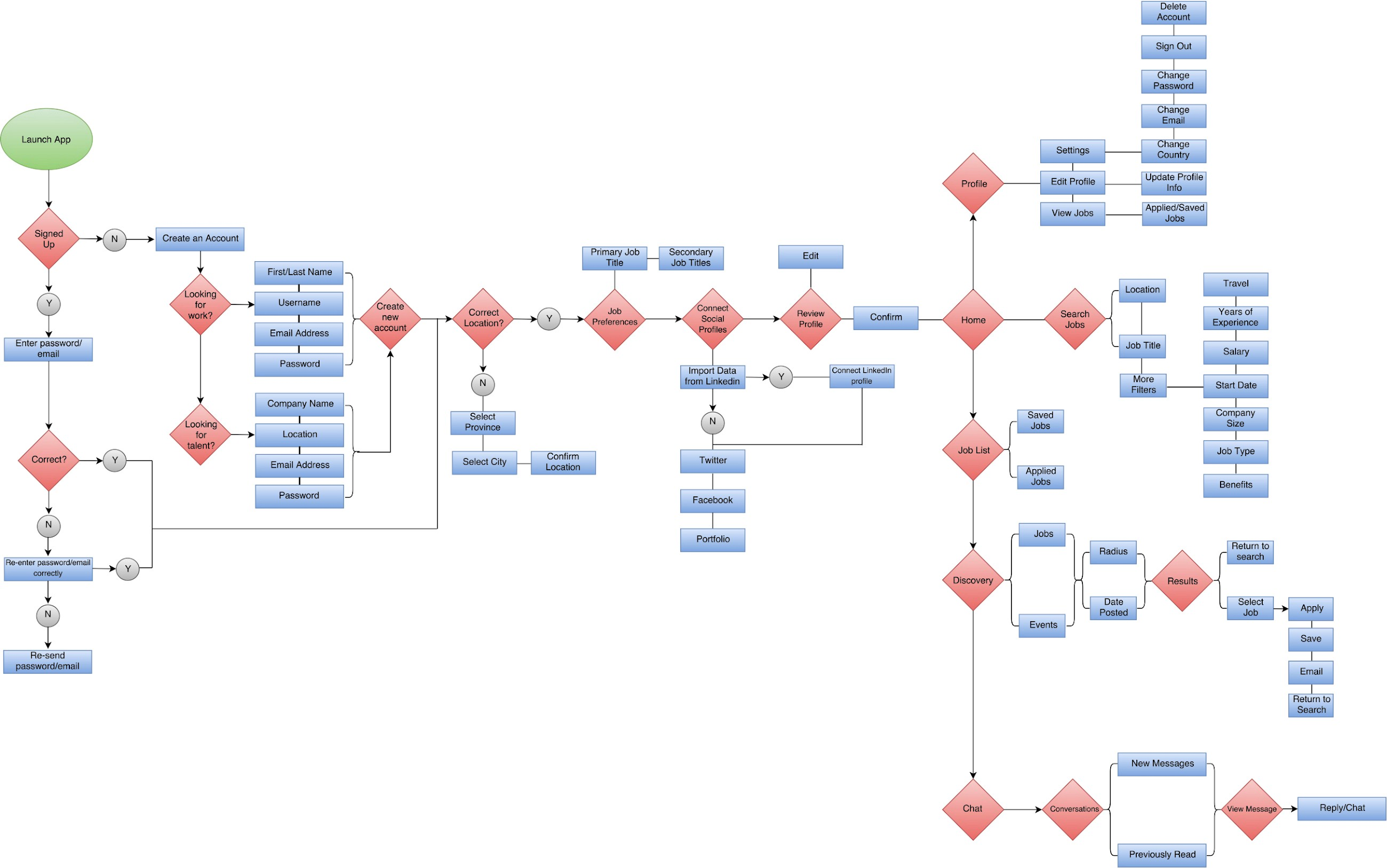
Wireframes are the blueprints for future UI. Basically, wireframes are the schemes that show how to arrange the elements on the page and how they should behave. But, wireframes don’t depict what those elements should look like.
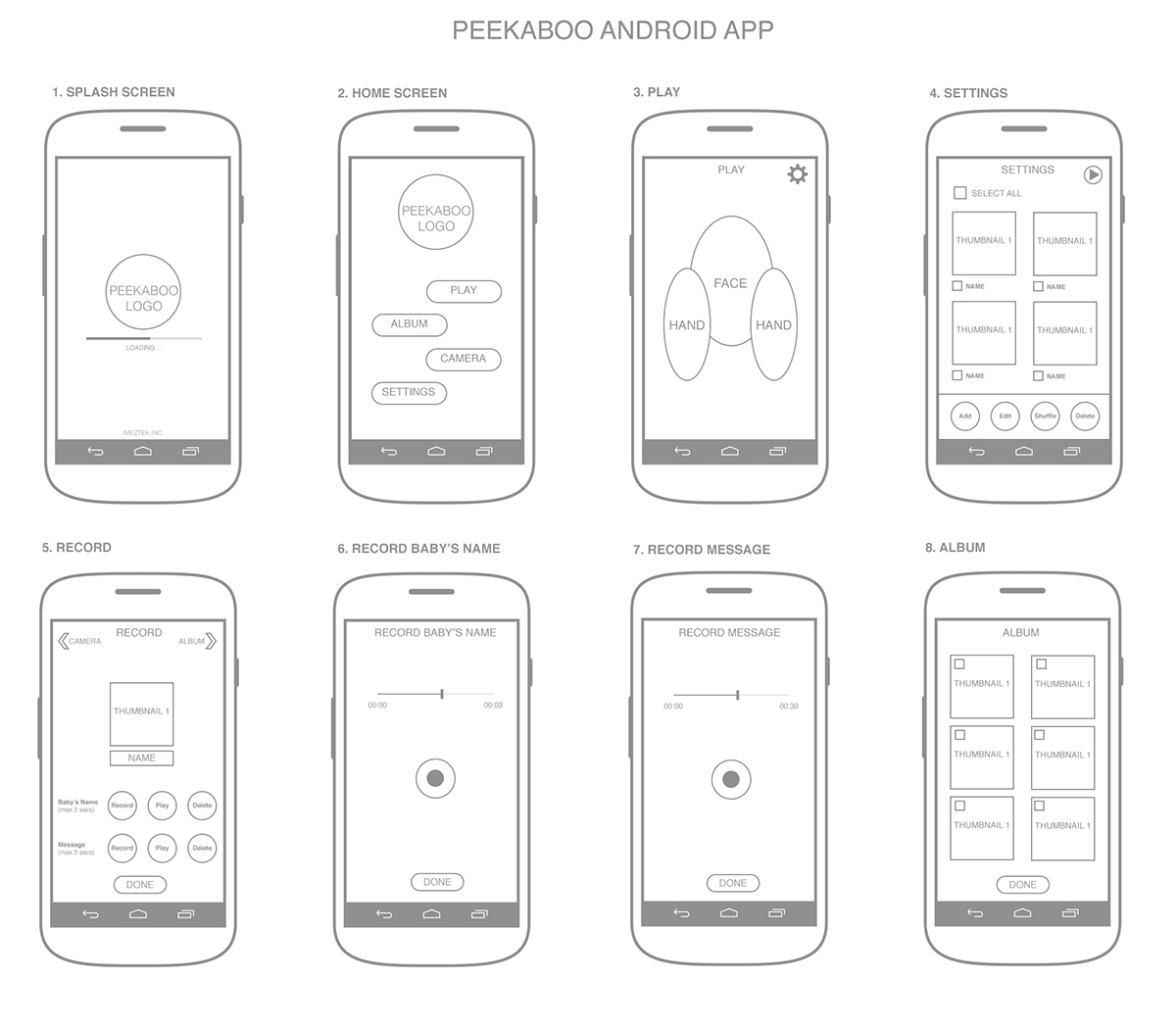
A mock-up is the next product design stage, showing the actual look and feel of a product. Basically, mock-ups are static images representing the final product design.
A prototype is a mock-up that you can interact with: click some buttons, navigate between different pages, and so on. A prototype can be created in a prototyping tool like Sketch or MockFlow. Using templates, UX designers can create interactive mock-ups on the early stages of development to be employed for usability testing.
A usability testing report is a short-form feedback document created to communicate the results of usability testing. The report should be as short as possible, with visual examples prevailing over text.
Software architecture design documents include the main architectural decisions which are made by solution architect. We don’t recommend listing everything, but rather focus on the most relevant and challenging ones. An effective design and architecture document comprises the following information sections:
Software design document template. Discuss and form a consensus with stakeholders regarding what needs to be covered in the architecture design document before it has been created and use a defined template to map architectural solutions.
Architecture & Design Principles. Underline the guiding architecture and design principles with which you will engineer the product. For instance, if you plan to structure your solution using microservices architecture, don’t forget to specifically mention this.
User Story description. Connect user stories with associated business processes and related scenarios. You should try to avoid technical details in this section.
Solution details. Describe the contemplated solution by listing planned services, modules, components, and their importance.
Diagrammatic representation of the solution. Identify the diagrams that need to be created to help understand and communicate the structure and design principles.
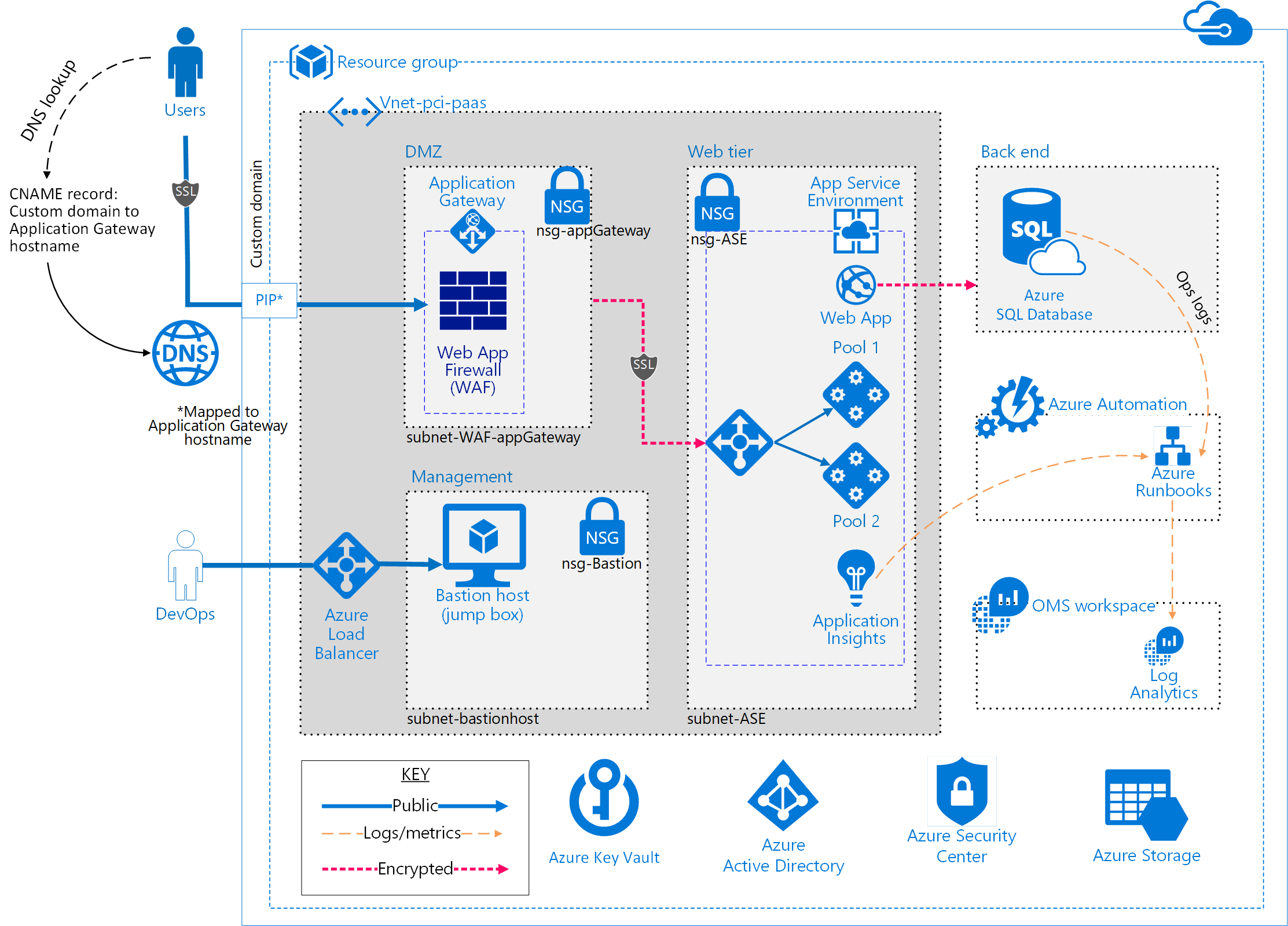
A source code document is a technical section that explains how the code works. While it’s not necessary, the aspects that have the greatest potential to confuse should be covered. The main users of the source code documents are software engineers.
Source code documents may include but are not limited to the following details:
Try to keep the document simple by making short sections for each element and supporting them with brief descriptions.
Quality assurance documentation
There are different types of testing documents in agile. We have outlined the most common:
A quality management plan is an analog of a requirement document dedicated to testing. This document sets the required standard for product quality and describes the methods to achieve this level. The plan helps to schedule QA tasks and manage testing activity for product managers, but, it is mainly used for large-scale projects.
A test strategy is a document that describes the software testing approach to achieve testing objectives. This document includes information about team structure and resource needs along with what should be prioritized during testing. A test strategy is usually static as the strategy is defined for the entire development scope.
A test plan usually consists of one or two pages and describes what should be tested at a given moment. This document should contain:
A test case specifications document is a set of detailed actions to verify each feature or functionality of a product. Usually, a QA team writes a separate specifications document for each product unit. Test case specifications are based on the approach outlined in the test plan. A good practice is to simplify specifications description and avoid test case repetitions.
Test checklist is a list of tests that should be run at a particular time. It represents what tests are completed and how many have failed. All points in the test checklists should be defined correctly. Try to group test points in the checklists. This approach will help you keep track of them during your work and not lose any. If it helps testers to check the app correctly, you can add comments to your points on the list.
Maintenance and help guide
This document should describe known problems with the system and their solutions. It also should represent the dependencies between different parts of the system.
API documentation
Nearly any product has its APIs or Application Programming Interfaces. Their documentation informs developers how to effectively use and connect to the required APIs.
API documentation is a deliverable produced by technical writers as tutorials and guides. This type of documentation should also contain the list of all available APIs with specs for each one.
As the name suggests, user documentation is created for product users. However, their categories may also differ. So, you should structure user documentation according to the different user tasks and different levels of their experience. Generally, user documentation is aimed at two large categories:
The documentation created for end-users should explain in the shortest way possible how the software can help solve their problems. Some parts of user documentation, such as tutorials and onboarding, in many large customer-based products are replaced with onboarding training. Nevertheless, there are still complex systems remaining that require documented user guides.
The online form of user documentation requires technical writers to be more imaginative. Online end-user documentation should include the following sections:
In order to provide the best service for end-users, you should collect your customer feedback continuously. The wiki system is one of the more useful practices. It helps to maintain the existing documentation. If you use the wiki system you won’t need to export documents to presentable formats and upload them the servers. You can create your wiki pages using a wiki markup language and HTML code.
System administrators documents don’t need to provide information about how to operate the software. Usually, administration docs cover installation and updates that help a system administrator with product maintenance. Here are standard system administrators documents:
Process documentation covers all activities surrounding product development. The value of keeping process documentation is to make development more organized and well-planned. This branch of documentation requires some planning and paperwork both before the project starts and during the development. Here are common types of process documentation:
Plans, estimates, and schedules. These documents are usually created before the project starts and can be altered as the product evolves.
Reports and metrics. Reports reflect how time and human resources were used during development. They can be generated on a daily, weekly, or monthly basis. Consult our article on agile delivery metrics to learn more about process documents such as velocity chats, sprint burndown charts, and release burndown charts.
Working papers. These documents exist to record engineers’ ideas and thoughts during project implementation. Working papers usually contain some information about an engineer’s code, sketches, and ideas on how to solve technical issues. While they shouldn’t be the major source of information, keeping track of them allows for retrieving highly specific project details if needed.
Standards. The section on standards should include all coding and UX standards that the team adheres to along the project’s progression.
The majority of process documents are specific to the particular moment or phase of the process. As a result, these documents quickly become outdated and obsolete. But they still should be kept as part of development because they may become useful in implementing similar tasks or maintenance in the future. Also, process documentation helps to make the whole development more transparent and easier to manage.
The main goal of process documentation is to reduce the amount of system documentation. In order to achieve this, write the minimal documentation plan. List the key contacts, release dates, and your expectations with assumptions.
Agile product roadmaps
Product roadmaps are used in Agile software development to document vision, strategy, and overall goals of the project. Roadmaps are used as process documents to keep the course of development in sync with initial goals. Depending on the type of product roadmap, it can express high-level objectives, prioritization of tasks, the sprint timeline, or low-level details.
There are three types of product roadmaps that are used by Agile product teams:
A strategic roadmap is a high-level strategic document, that contains overall information on the project. Strategic roadmaps usually state a vision and long-term goals. In the case of agile product development, a roadmap can be arranged in themes. Themes are multiple tasks that a team must complete and are somehow connected. For instance, a theme may sound like “enhance page-loading speed,” which entails a handful of actions.
Grouping the information around the themes makes a roadmap highly flexible and updatable, which is a great fit for sprint-based development. The best advice concerning strategic roadmapping is to include only important information. Otherwise, you risk turning your roadmap into a clumsy scheme, difficult to both understand and maintain.
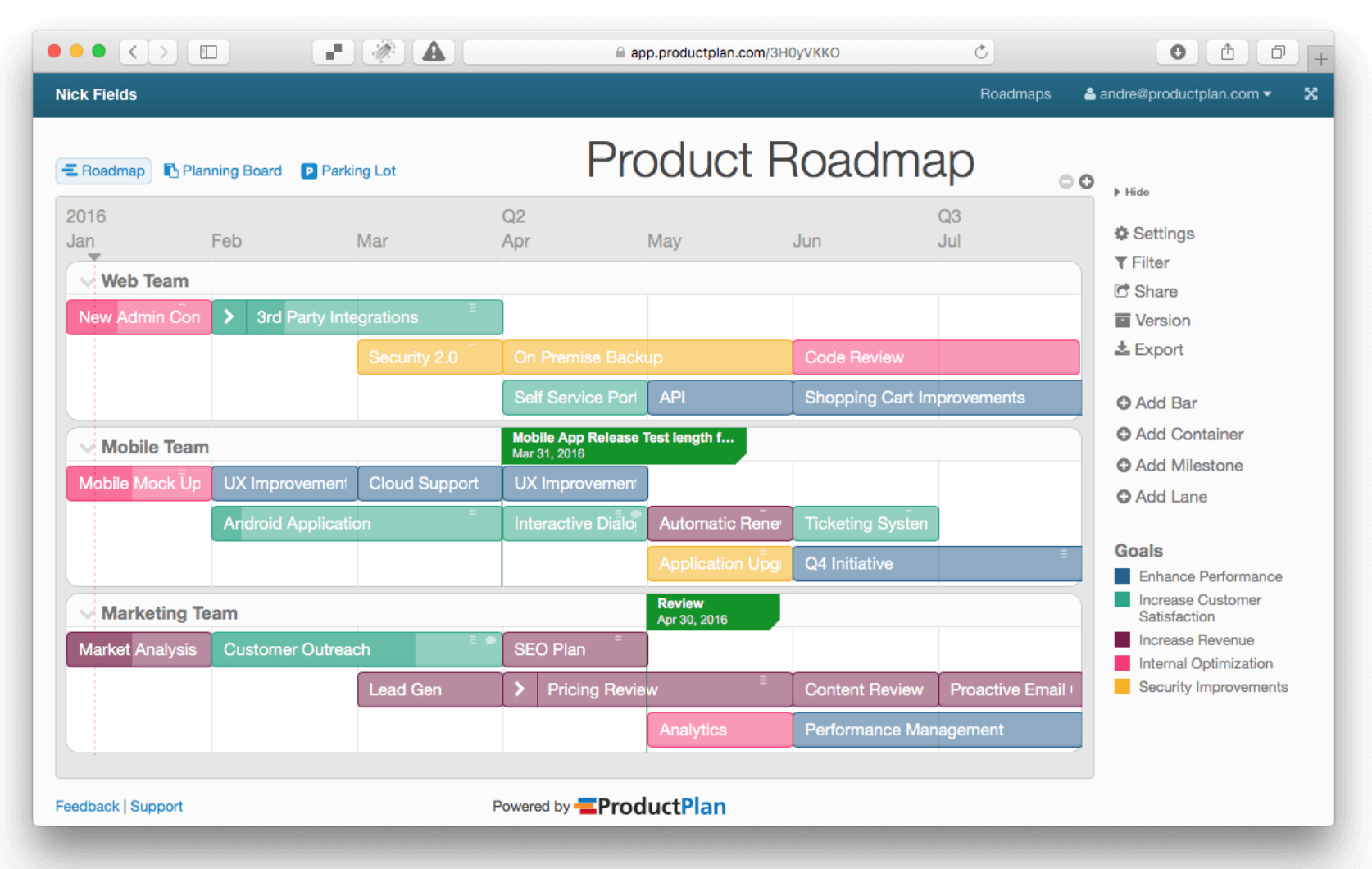
A technology roadmap or IT roadmap is a low-level document that describes technical requirements and the means of technology implementation. IT roadmaps are quite detailed. They contain the information on each deliverable, explaining the reason for such a decision.
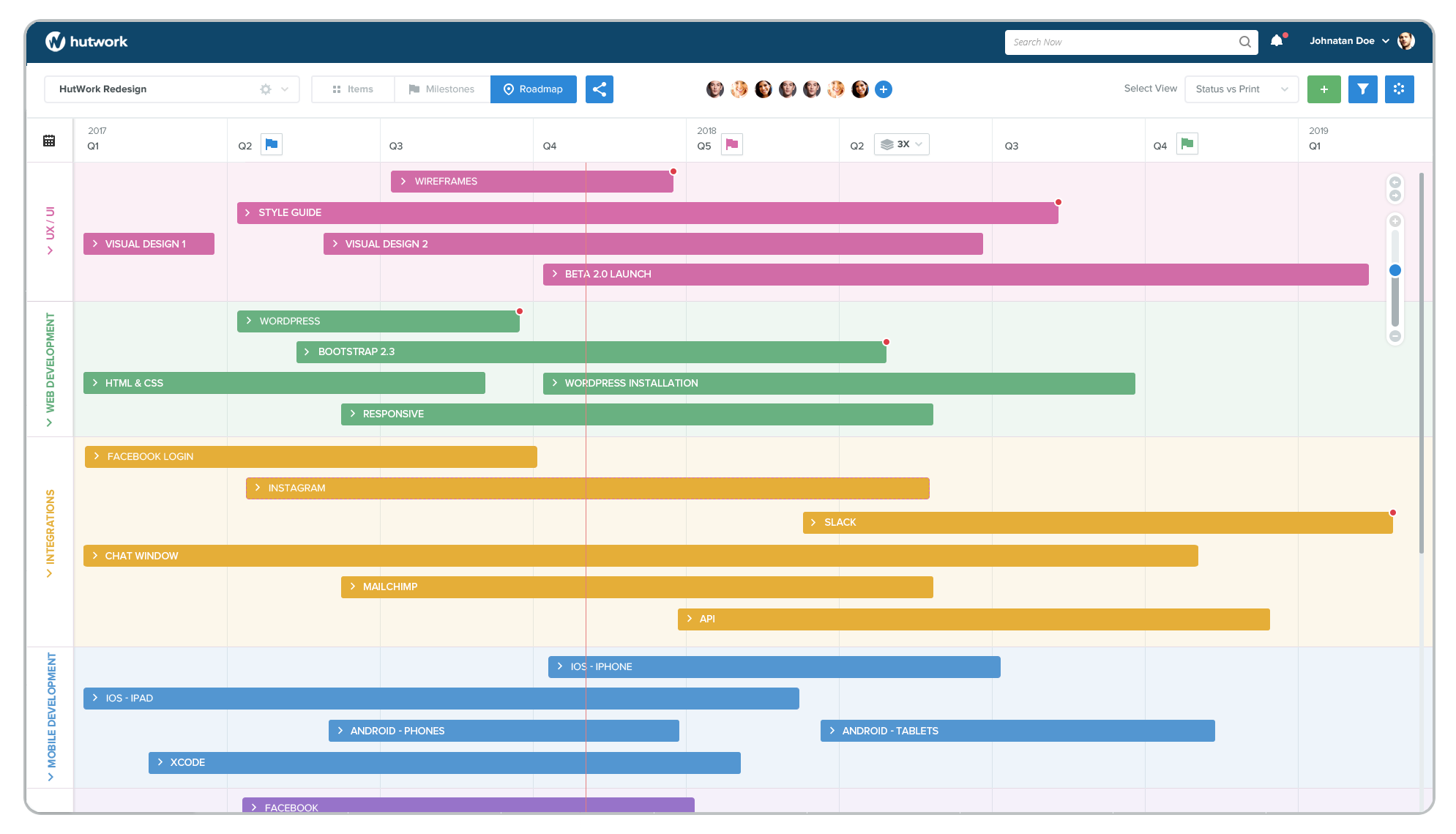
A release plan is used to set strict time limits for releases. A release plan should focus on the actual deadlines without specifying release details.
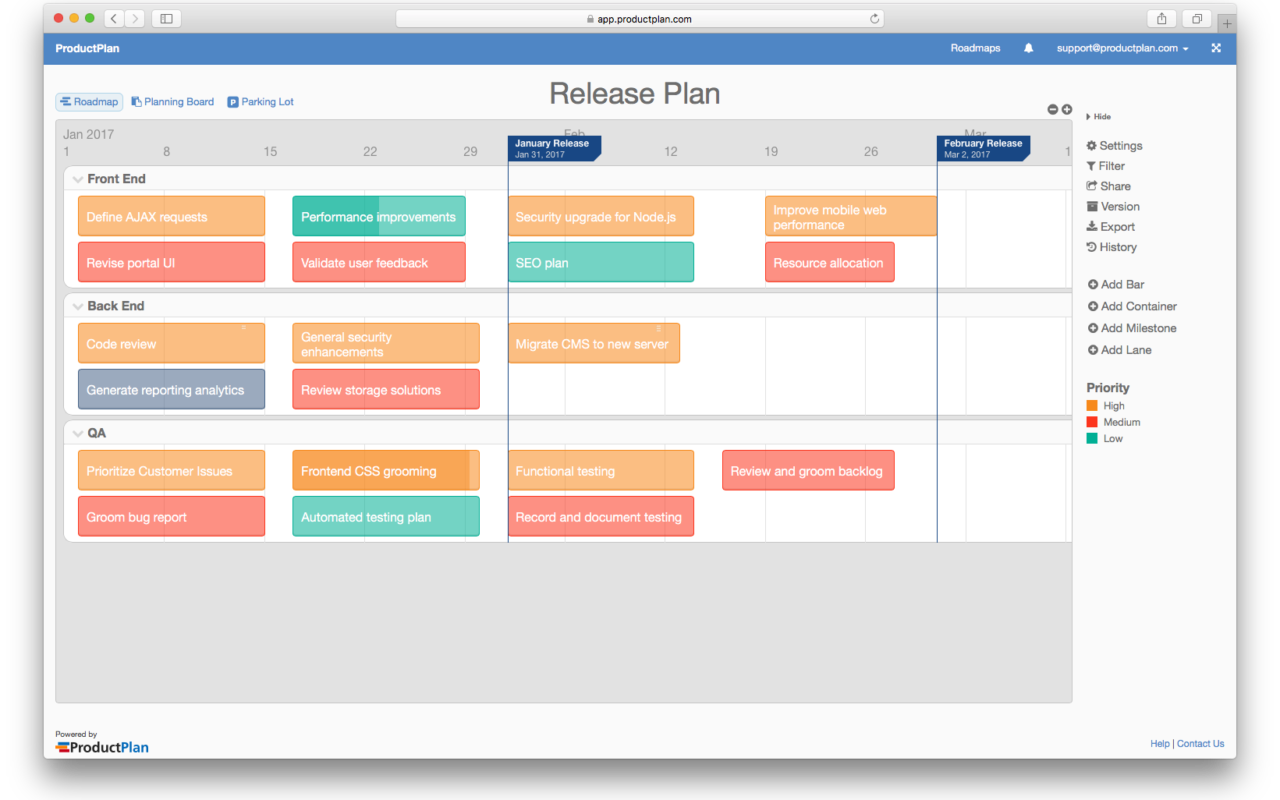
It is highly recommended to use roadmap specific tools to create your own roadmaps. Online tools like Roadmunk provide various templates for product roadmaps, allow quick editing, and provide easy sharing across all team members.
Keep in mind, that a roadmap, depending on its type, can be a product document that states requirements. It also describes the process and guides your team through development.
Tools for software documentation
General purpose tools
There are countless collaborative tools for software development teams. Those can help to state requirements, share information, and document features and processes:
Markdown editors
As software documentation is easier to be used on the web, it has to be created in a proper format. That’s why text-based markup languages are used. The most popular one is Markup, which can be easily converted into HTML, doesn’t require any special knowledge to use it. Markup is used on GitHub and Reddit, and basically everywhere for web-based documentation. So, here are some Markdown editors that can be useful for creating documents for your project:
Roadmap specific tools
It’s a good practice to use roadmap specific tools, as they allow you to share the information quickly, update timelines or themes, add new points, and edit the whole structure. Most roadmapping tools provide templates for different roadmaps to let you start working with this document right away.
Basically, all the tools offer free trials and paid plans with differences in templates, numbers of roadmaps, and persons you can share them with.
Tools for UX documentation
The most popular tools for user experience design are prototyping tools that help create sketches, mock-ups, wireframes, and interactive prototypes:
Tools for API documentation
The process of creating API documentation is most often automated. Programmers or tech writers may write the documentation manually or use API documentation generators:
Samples and templates for software documentation
If your team is struggling to find a qualitative template for some type of software documentation, here are sources of documentation templates:
How to write software documentation: general advice
There are several common practices that should be applied to all the major types of documentation we discussed above:
Write just enough documentation
You should find a balance between no documentation and excessive documentation. Poor documentation causes many errors and reduces efficiency in every phase of software product development. At the same time, there is no need to provide an abundance of documentation and to repeat information in several papers. Only the most necessary and relevant information should be documented. Finding the right balance also entails analyzing the project’s complexity before development starts.
Documentation is an ongoing process
This means that you should keep your documentation up-to-date. It is very important as documents that aren’t current automatically lose their value. If requirements change during software development, you need to ensure that there’s a systematic documentation update process that includes information that has changed. You can use automatic version control to manage this process more efficiently.
Documentation is the collaborative effort of all team members
The agile method is based on a collaborative approach to creating documentation. If you want to achieve efficiency, interview programmers and testers about the functionalities of the software. Then, after you have written some documentation, share it with your team and get feedback. To get more information try to comment, ask questions, and encourage others to share their thoughts and ideas. Every team member can make a valuable contribution to the documents you produce.
Hire a tech writer
If you can, it worth hiring an employee who will take care of your documentation. The person who generally does this job is called a technical writer. A tech writer with an engineering background can gather information from developers without requiring someone to explain in detail what is going on. It’s also worth embedding a technical writer as a team member, locating this person in the same office to establish close cooperation. He or she will be able to take part in regular meetings and discussions.
Use cross-links
Use cross-links between documents, whether those are product pages or user guides. Proper navigation through your documentation is important to give the reader the right understanding of a subject. Such practice can be considered user-flow, but for your project documentation.
Don’t ignore glossaries
Documentation can be dedicated to internal or external usage. In the case of external documents, it is better to provide a clear explanation of every term, and its specific meaning in the project. Documentation should communicate ideas in clear language to set lingua franca between stakeholders, internal members, and users.
Final word
The agile methodology encourages engineering teams to always focus on delivering value to their customers. This key principle must also be considered in the process of producing software documentation. Good software documentation should be provided whether it is a software specifications document for programmers and testers or software manuals for end users. Comprehensive software documentation is specific, concise, and relevant.
As we have mentioned above, it’s not obligatory to produce the entire set of documents described in this article. You should rather focus only on those documents that directly help achieve project objectives.